18.08.2022
Artemis: Nasa readies giant Moon rocket for maiden flight

The American space agency Nasa has rolled out its giant new Moon rocket to prepare it for a maiden flight.
Known as the Space Launch System (SLS), the vehicle was moved to Pad 39B at the Kennedy Space Center in Florida ahead of the expected lift-off on 29 August.
The debut outing is a test with no crew aboard, but future missions will send astronauts back to the lunar surface for the first time in over 50 years.
The near 100m-tall (328ft) SLS rode an immense tractor to the pad.
It started moving from its assembly building at Kennedy just before 22:00 on Tuesday, local time, and had completed the 6.7km (4.2 miles) journey by just after sunrise on Wednesday morning.
This is a key moment for Nasa, which will celebrate in December the half-century anniversary of Apollo 17, the very last human landing on the Moon.
The agency has vowed to return with its new Artemis programme, using technology that befits the modern era (Artemis was Greek god Apollo's twin sister and goddess of the Moon).
Nasa sees a return to the Moon as a way to prepare to go to Mars with astronauts sometime in the 2030s or soon after.
The SLS will have 15% more thrust off the pad than Apollo's Saturn V rockets. This extra power, combined with further enhancements, will allow the vehicle to not only send astronauts far beyond Earth but, additionally, so much equipment and cargo that those crews could stay away for extended periods.

The crew capsule, also, is a step up in capability. Called Orion, it is much more spacious, being a metre wider, at 5m (16.5ft), than the historic command modules of the 1960s and 70s.
"To all of us that gaze up at the Moon, dreaming of the day humankind returns to the lunar surface - folks, we're here! We are going back. And that journey, our journey, begins with Artemis 1," said Nasa Administrator Bill Nelson.
"The first crewed launch, Artemis 2, is two years from now in 2024. We're hoping that the first landing, Artemis 3, will be in 2025," he told BBC News.
Nasa has promised that this third mission will witness the first woman to put her boots down on the Moon's surface.

Once the SLS arrives at its launch pad, engineers will have just over a week and a half to get the vehicle ready for flight.
Three possible launch opportunities exist at the end of the month, starting with Monday 29 August.
If technical issues or inclement weather prevent the rocket from getting off Earth on this date, a further attempt can be made on Friday 2 September, and, failing that, on Monday 5 September.
The scope of the mission is to send Orion looping around the back of the Moon before bringing it home for a splashdown in the Pacific Ocean off California.
A major objective of the test fight is to check the heatshield on the capsule can survive the heat of re-entry into Earth's atmosphere.
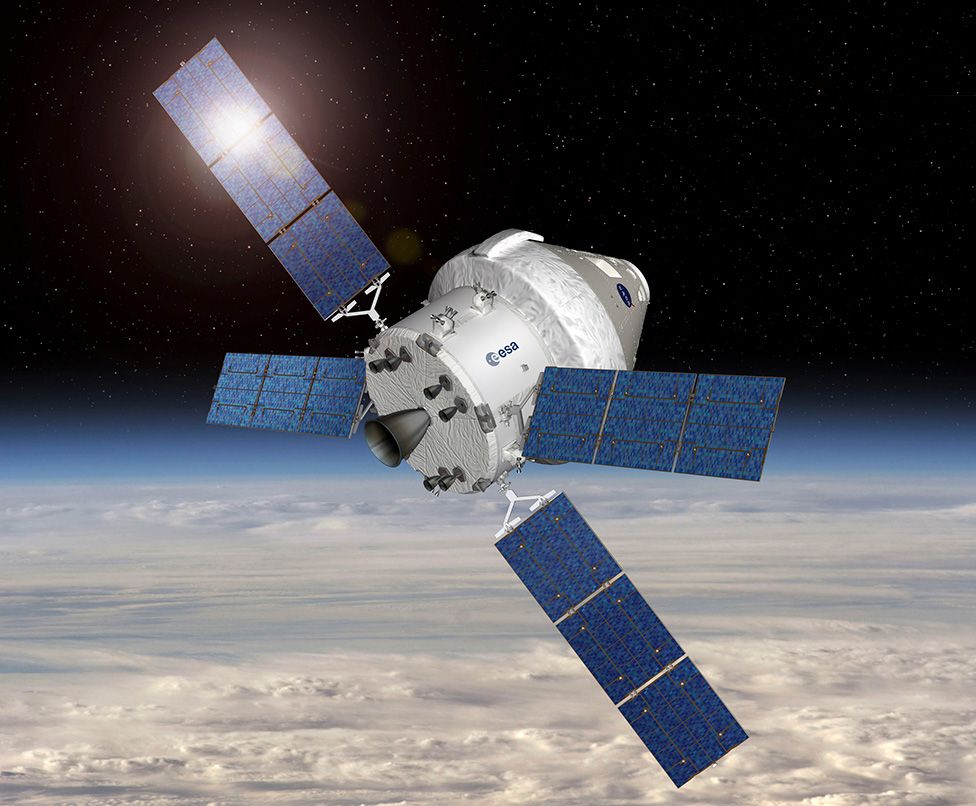 IMAGE SOURCE, ESA
IMAGE SOURCE, ESAA key partner on the upcoming mission is Europe.
It is providing the propulsion module that sits on the back of Orion, pushing it through space.
"More than 10 countries in Europe have been working on this European Space Agency (Esa) contribution. It's a hugely important moment for us," explained Siân Cleaver from aerospace manufacturer Airbus.
"The European Service Module is not just a payload, it's not just a piece of equipment - it's a really critical element because Orion can't get to the Moon without us."
Europe hopes its contribution to this and future SLS/Orion missions will eventually see a European national get to be part of a lunar surface crew at some point.
For now, it will have to cheer on the British animated character Shaun the Sheep. A puppet used in the stop-motion TV films has been placed in the Orion capsule, complete with an Esa badge and Union flag on its overalls.
While Nasa is developing the SLS, the American rocket entrepreneur Elon Musk is preparing an even larger vehicle at his R&D facility in Texas.
He calls his giant rocket the Starship, and it will play a role in future Artemis missions by linking up with Orion to get astronauts down to the surface of the Moon.
Like SLS, Starship has yet to have a maiden flight. Unlike SLS, Starship has been designed to be totally reusable and ought therefore to be considerably cheaper to operate.
A recent assessment from the Office of Inspector General, which audits Nasa programmes, found that the first four SLS missions would each cost more than $4bn to execute - a sum of money that was described as "unsustainable".
The agency said changes made to the way it contracts industry would bring down future production costs significantly.
Quelle: BBC
+++










Quelle: NASA
----
Update: 24.08.2022
.
Artemis: Nasa Moon mission gets go-ahead to launch
The American space agency says it is ready to launch its giant new Moon rocket next Monday.
Nasa officials conducted a flight-readiness review late on Monday and concluded there were no substantive technical issues in their way.
The rocket, known as the Space Launch System, will send a capsule, called Orion, on an excursion around the Moon.
Uncrewed this time, there will be astronauts on board for subsequent missions, assuming all goes to plan.
The SLS will go up from the Kennedy Space Center (KSC) in Florida.
The vehicle has been given a two-hour window on the Monday to get off Earth, starting at 08:33 local time (12:33 GMT; 13:33 BST).
"We actually had no actions coming out of the review and we had no dissenting opinions," said Jim Free, Nasa's associate administrator for exploration systems development.
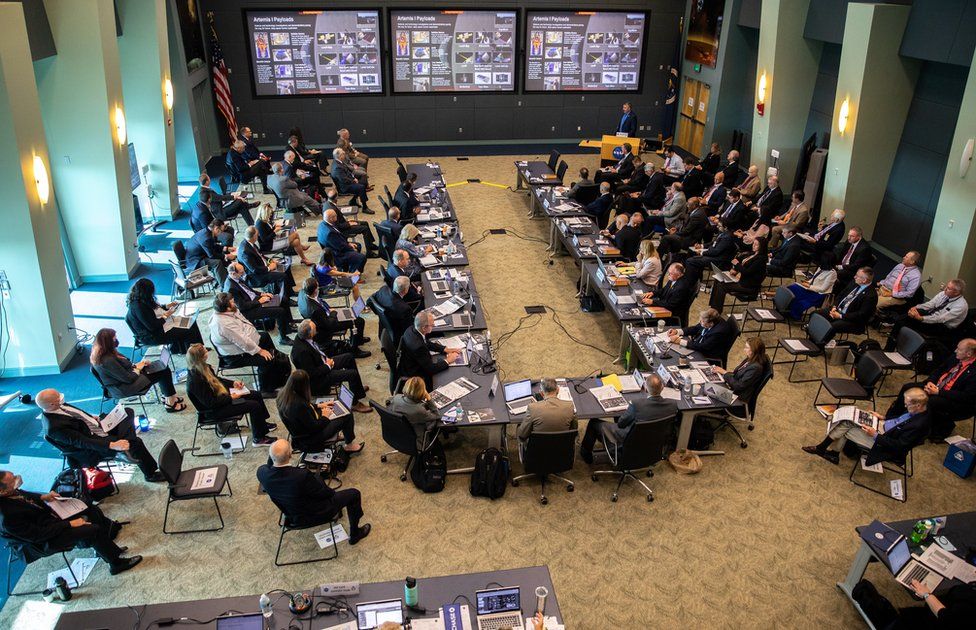 IMAGE SOURCE, NASA
IMAGE SOURCE, NASAThe launch will be a key moment for Nasa, which, in December, will celebrate the 50th anniversary of the last human landing on the Moon - Apollo 17.
The agency has vowed to return with its new "Artemis programme", using technology that befits the modern era (Artemis was Greek god Apollo's twin sister and goddess of the Moon).
Nasa sees a return to the Moon as a way to prepare to go to Mars with astronauts sometime in the 2030s or soon after.
"You know, right now more than half the world's population has never seen anybody walk on another world, so in many ways it is going to be their first moon walk," said Keith Cowing, the editor of the Nasa Watch website which covers Nasa news.
"We do things differently, everything is instant, everything's going to be in HD... It's going to be exciting and noisy, but at the end of the day eventually we're going to be sending humans to walk on another world and again hopefully maybe this time it'll be a global effort, not two countries competing with each other," he told BBC News.
SLS and Orion have been in development for over a decade and have cost, in each case, more than $20bn (£17bn) to get to this point.
Orion has actually flown before, once, on a near-Earth test outing in 2014. But that used an existing commercial rocket to get into space. This coming flight is therefore the first full end-to-end examination of the Artemis exploration hardware.
A guide to Nasa's mega Moon rocket
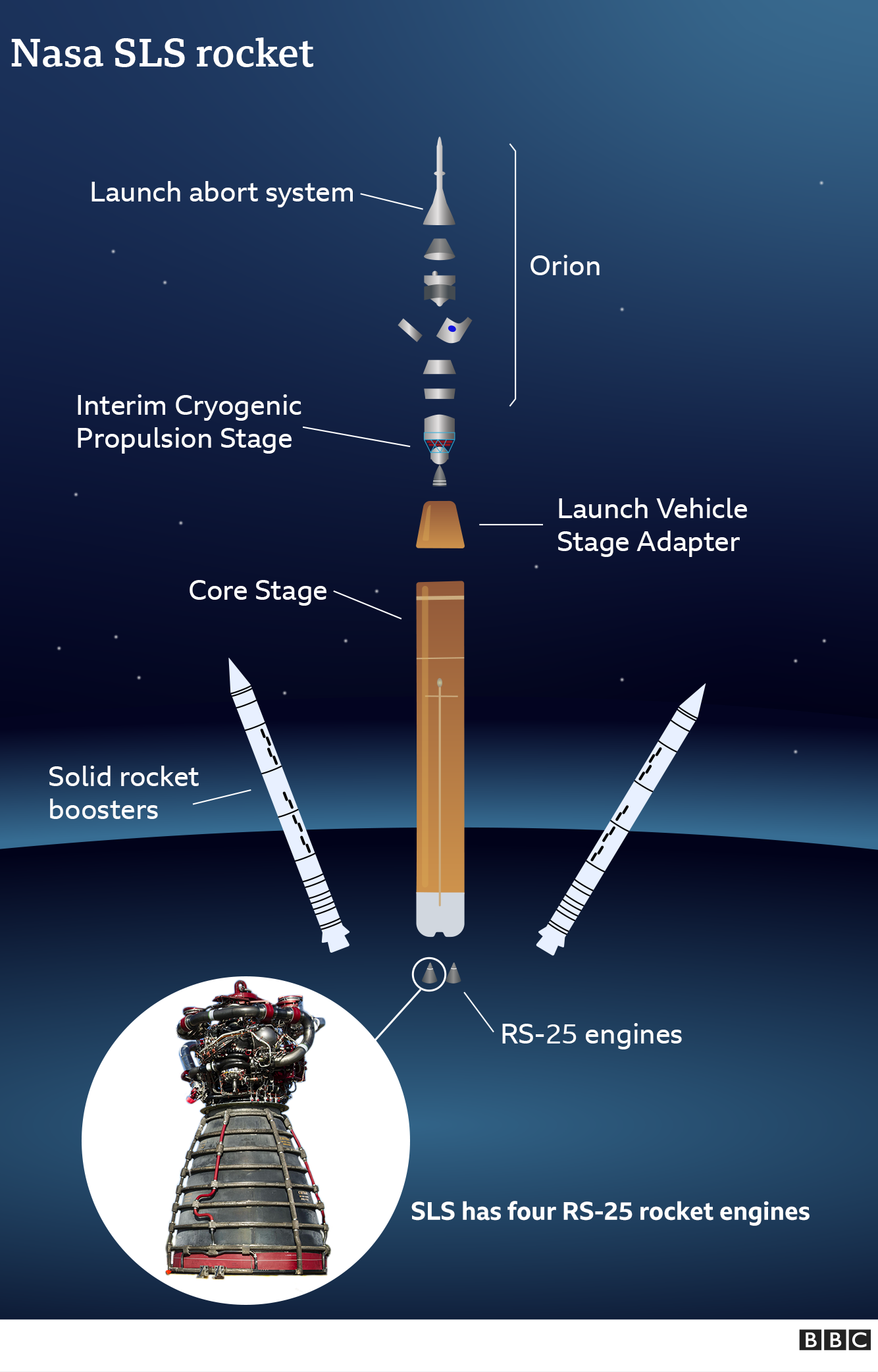
SLS and Orion were rolled out to the launch pad last week. Engineering and technical staff have spent the intervening days attaching fuel, electrical and communication lines in readiness for the big countdown.
This should begin with a "call to stations" for the Artemis I launch team at 09:53 EDT on Saturday, with the operation to load SLS with 2.7 million litres of propellants (liquid hydrogen and oxygen) set to get under way just after midnight into the Monday.
"We've completed 30 sims, so our team is certified and ready to go," said launch director Charlie Blackwell-Thompson.
Nasa is expecting hundreds of thousands of spectators to line the beaches along the space coast.
This will be the most powerful rocket ever to pull away from Kennedy, producing 39.1 meganewtons (8.8 million pounds) of thrust off the pad. That's close to 15% more than from Apollo's Saturn V rockets and over 20% more than from the old space shuttle system.
Put another way, the SLS's engines could power the equivalent of almost 60 Concorde supersonic jets on take-off.
"I can tell you there's an energy and there's an excitement around the Kennedy Space Center; I would say across the agency and all around the Space Coast as we get closer and closer to this launch," commented Janet Petro, the director at KSC.
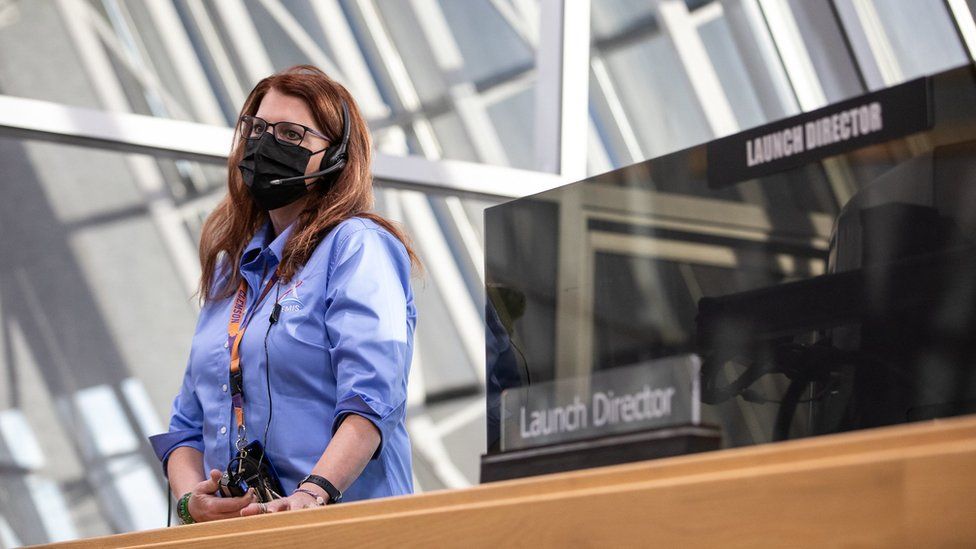 IMAGE SOURCE, NASA
IMAGE SOURCE, NASAOrion will be sent on a 42-day mission to, and beyond, the Moon.
It's expected back on Earth for a splashdown in the Pacific Ocean close to San Diego, California, on 10 October.
Artemis II, the first crewed mission to use SLS-Orion, is being targeted at 2024. Artemis III, the first landing on the lunar surface since 1972, won't occur any earlier than late 2025.
Nasa has yet to name any astronauts for these missions, but it has published in the last few days the locations on the lunar surface where future crews could be sent.
It has identified 13 candidate destinations. They're all within six degrees of latitude of the lunar South Pole (Apollo was largely confined to equatorial or near-equatorial landing sites).
The aim is to get close to permanently shadowed areas where water-ices are likely to have collected over billions of years.
These ices could be used for drinking water or to make rocket fuel.
Speaking shortly after Monday's review was completed, Bob Cabana, a former shuttle astronaut and now Nasa's associate administrator, said: "I'm a product of the Apollo generation, and look what it did for us. I cannot wait to see what comes from the Artemis generation because I think it's going to inspire even more than Apollo did. It's going to be absolutely outstanding."
Quelle: BBC
+++
Three mannequins installed on Orion spacecraft for flight around the moon

Three instrumented mannequins strapped into seats on NASA’s Orion spacecraft awaiting liftoff on the first flight of the huge Space Launch System rocket will help engineers evaluate the human experience for future astronauts trips to the moon.
The three mannequins — one wearing an Orion astronaut spacesuit and two others in recumbent passenger seats — were recently installed inside the pressurized cabin of the Orion spacecraft inside the Vehicle Assembly Building at the Kennedy Space Center in Florida.
They were aboard the Orion capsule on top of the SLS moon rocket when it rolled to the launch pad early Aug. 17 for final countdown preparations. The mannequins are fitted with thousands of sensors to measure acceleration, vibration, and radiation levels throughout the Orion spacecraft’s trip from Earth to the moon and back.
The SLS moon rocket and Orion spacecraft are scheduled for liftoff no earlier than Aug. 29 to begin NASA’s Artemis 1 mission, an unpiloted shakedown cruise before follow-on SLS/Orion launches carry astronaut crews toward the moon. NASA’s Artemis program is intended to return astronauts to the moon’s surface, establish a long-term presence there, and test technologies for future human expeditions to Mars.
“Artemis 1’s primary mission is to validate the envelope of performance for the crew transportation system that will serve as our workhorse for the crew lunar and Mars missions,” said Pat Troutman, a designer and architect in NASA’s Moon to Mars architecture development office.
The Orion spacecraft will travel past the moon and swing into a distant retrograde orbit with an average distance of more than 43,000 miles (70,000 kilometers) from the lunar surface. At that distance from Earth, the spacecraft will be flying outside the magnetic field that shields the planet from solar and cosmic radiation.
Artemis 1 also carries a range of secondary payloads, including deployable subsatellites, or CubeSats, to pursue scientific and technology demonstration missions. There are experiments and payloads inside the Orion spacecraft, too.
“The science and technology payloads on this mission, they’re going to tell us about the environment that humans will travel through, and they’re going to push the envelope with respect to what advanced technology can do for us on these future missions,” Troutman said. “So these payloads will inform us how to better protect the crew from the space radiation, and demonstrate advanced propulsion capabilities, enabling us to more efficiently send probes and humans to deep space.
“They’ll demonstrate autonomy and special technologies that will help future Mars crews inspect their spaceships without having to leave the safety of their pressurized cabins,” Troutman said.

One of the mannequins flying on the Artemis 1 mission wears an orange spacesuit similar to the one that astronauts will put on for launch and re-entry on future Artemis flights.
“The goal is to simulate, test, evaluate the human experience of launch and landing,” said Dustin Gohmert, Orion crew survival systems project manager at NASA’s Johnson Space Center in Houston. “Artemis 1 is uncrewed. But with the mannequin, we’ll be able to evaluate how that human behaves on the vehicle.
“This spacesuit that we have — the Orion Crew Survival Suit, or OCSS — will be worn by all future astronauts from Artemis 2 and beyond on all the subsequent missions,” Gohmert said.
The suit is designed to sustain an astronaut for up to six days, providing the crew member with oxygen, cooling and other life-sustaining functions if the Orion spacecraft loses cabin pressure in flight. That could give the Orion spacecraft time to make an emergency return to Earth from the vicinity of the moon.
“That’s a feat we’ve never before attempted in the history of spacesuits,” Gohmert said.
“By and large, the suit is functionally identical to what we will be flying for Artemis 2 and beyond,” he said.
The mannequin wearing the Orion spacesuit is named “Commander Moonikin Campos” in honor of Arturo Campos, an engineer responsible for the electrical systems on the Apollo lunar module. His expertise was instrumental in allowing the Apollo 13 astronauts to use the lunar module as a lifeboat for their return to Earth.
Gohmert said “Campos” will will be riding on the Orion spacecraft in a “fully flight-like seat.”
“It’s designed with advanced occupant safety features that we’ve incorporated through the last decade of study, and we’ve done that to maximize human safety,” Gohmert said. “The NASA crew survival engineering team … we’ve spent this last decade working to create a fully integrated crew safety system. And to do that, we had to combine the vehicle, the suit, the seat, and the human all into one protective package. With this mission, we’re going to measure some of the important aspects of those launch safety features.
“With the mannequin, we’ll be able to look at the dynamic responses of that system,” Gohmert said. “This is important because it allows us to take what we’ve learned from testing and from modeling and validate that against the real world performance, so that we can ensure the safety of all the future astronauts.”
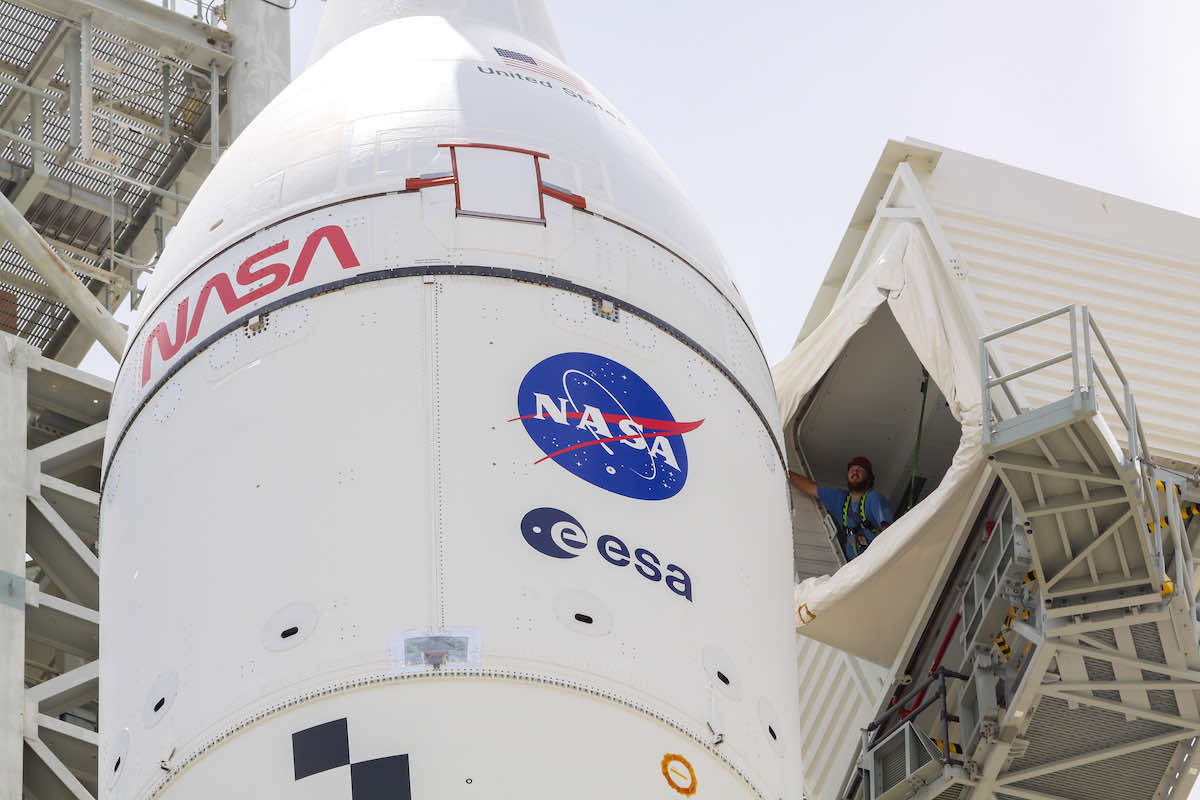
Commander Moonikin Campos is equipped with two radiation sensors, and its seat has sensors under the headrest and behind the seat to capture acceleration and vibration measurements throughout the mission, including liftoff, re-entry, and splashdown in the Pacific Ocean.
The Orion spacecraft has additional accelerometers to compare the forces that affect the upper and lower level seats inside the capsule. Future Orion missions will carry crews of four astronauts.
Astronauts on the Orion spacecraft are expected to experience 2.5 times the force of gravity during launch and four times the force of gravity during re-entry, according to NASA.
Two “co-passengers” are also aboard the Orion spacecraft for the Artemis 1 mission. Two “phantom torsos” are strapped into passenger seats inside the capsule to gather data about the radiation exposure astronauts will encounter on lunar expeditions.
The two female-bodied phantoms, named Helga and Zohar, are made out of epoxy resin. Radiation interact with the resin material in a similar way to how it impacts human bones, tissue and organs, according to Thomas Berger, principal investigator for the phantom torsos at DLR, the German Aerospace Center.
There are more than 10,000 sensors embedded in the phantoms to collect radiation measurements at different parts of the body.
“Besides the difference between a man and a woman when it comes to biological effects, we will differentiate between different body organs, between the brain and the uterus, for example,” said Ramona Gaza, science team lead for the Matroshka AstroRad Radiation Experiment, or MARE, investigation.

One of the two German-provided phantoms will wear a radiation vest developed by the Israeli company StemRad and supported by the Israel Space Agency. The vest will allow scientists to test mitigation measures for astronauts to protect themselves during a solar storm that could shower the Orion spacecraft with radiation.
The Orion spacecraft’s pressurized cabin will also carry an investigation called Biology Experiment 1, which hosts plant seeds, fungi, yeast, and algae.
“Each of these four experiments will help us understand a unique aspect of how biological systems can adapt and thrive in deep space,” said Sharmila Bhattacharya, NASA program scientist for space biology. “Gathering information like this and analyzing it after flight will eventually help us paint the full picture of how we can help humans thrive in deep space.”
Assuming the Artemis 1 mission takes off Aug. 29, the Orion spacecraft will spend 42 days in space before returning home for a parachute-assisted splashdown Oct. 10 in the Pacific Ocean west of San Diego.
Quelle: SN
----
Update: 27.08.2022
.
NASA Artemis I launch weather Monday should be OK, weekend storms expected for SpaceX
Florida summertime weather could threaten a SpaceX Falcon 9 launch scheduled for Saturday night from Cape Canaveral Space Force Station. On the other hand, conditions for Monday morning's highly anticipated liftoff of NASA's massive Space Launch System rocket and Orion capsule from Kennedy Space Center seem to be more favorable.
On Saturday night SpaceX teams will likely have to contend with 40% "go" conditions for the 58th liftoff of dozens of Starlink satellites at 10:22 p.m. EDT from LC-40 at Cape Canaveral Space Force Station. But, Space Force forecasters expect those conditions to improve to around 60% throughout the launch window which closes just after midnight.
"Showers and thunderstorms will begin to form along the east coast sea breeze around noon and move slowly westward," Space Launch Delta 45 forecasters said Thursday. "Showers and storms will decrease into the night, so weather at the end of the launch window will likely be most favorable."
Should teams fly on Saturday, recovery conditions for a Falcon 9 booster landing on a drone ship stationed in the Atlantic Ocean are listed as "low-risk" as are upper-level wind concerns.
"On Sunday, a pattern shift back to southeast flow is expected, which should decrease the coverage of the showers and thunderstorms along the Space Coast," forecasters said Thursday.
"This flow regime will remain in place for the opening of the initial launch window Monday morning," forecasters said expecting the 70% chance of "go" conditions to stick around for the launch of NASA's 322-foot Space Launch System rocket.
The mega moon rocket stacked with an uncrewed Orion capsule on top for the Artemis I mission around the moon and back is slated to fly from Kennedy Space Center's pad 39B at 8:33 a.m. EDT Monday, Aug. 29.

The window for that launch will last for around two hours. If the Artemis I mission takes off on Monday it will propel the Orion capsule on a 42-day mission around the moon with a splashdown landing off the coast of California slated for October.
Should it be needed, NASA also has backup opportunities to launch the SLS rocket and Artemis I mission on Friday, September 2, and Monday, September 5, (Labor Day).
If all goes according to plan, that will pave the way for Artemis II – roughly the same mission but with astronauts – sometime in 2024.
Then the Artemis III mission will put two astronauts on the lunar surface sometime after 2025.
Launch August 29: NASA Artemis I
- Company / Agency: NASA
- Rocket: Space Launch System
- Location: Pad 39B at Kennedy Space Center
- Launch Time: 8:33 a.m. EDT
- Trajectory: Northeast
- Weather: 70%
- Live coverage: Starts at 5 a.m. at floridatoday.com/space
- About: NASA's highly anticipated Space Launch System will make its premiere for this mission known as Artemis I. It does not include astronauts, but the uncrewed Orion capsule will fly around the moon before returning to Earth for splashdown. If successful, it will pave the way for astronauts to do the same on Artemis II and, eventually, land on the lunar surface for Artemis III.
Quelle: Florida Today
